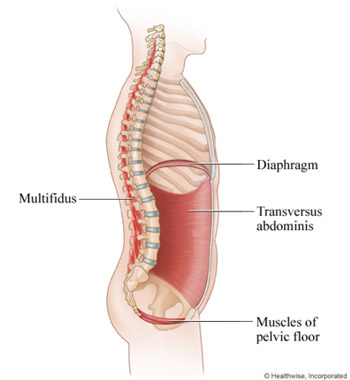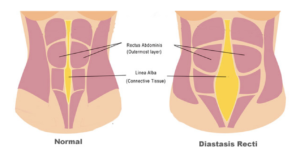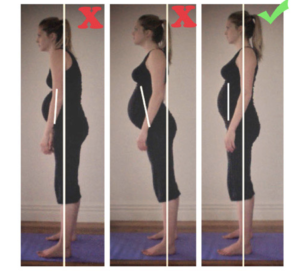The education we receive about our pregnant and postpartum bodies continues to be dismal at best. From the awful “just keep doing what you were doing before you were pregnant” advice to the six-week clearance for exercise, I’m continually shaking my head wondering when it will stop. Simply put, once we are pregnant and postpartum, our bodies are different and require a different training approach. It just makes sense!
Why Can’t I Flatten My Tummy After Childbirth?
One of the complaints I hear most often from postpartum women is that they can’t seem to flatten or “tone” their stomachs months or even years after birth. They complain about the “mummy tummy” or the “spare tire” around their waists. I always ask these two questions:
1. Do you have diastasis recti?
2. Have you ever done a postpartum rehab program that reconnects your deep core muscles?
The answers I usually get are “dia-what?” and “uh… No.”
The next question I ask is sometimes uncomfortable, but as your trainer, I absolutely need to know this (and so do any personal trainers or health professionals who work with pre or postnatal women!).
“Do you ever leak when you work out? Jump? Sneeze?”
And it’s not uncommon for the answer to be “yes.”
Diastasis recti and pelvic floor issues are related. If a woman has one, it wouldn’t be surprising for her to have the other (although they present separately as well!). They are both symptoms of having an uncoordinated core and faulty internal pressure system.
What Is “The Core?”
When I’m talking about your core, I don’t mean your abs. I’m talking about your deep core, the muscles that stabilize you and should turn on before any movement. These muscles include the diaphragm, transverse abdominis, multifidus and pelvic floor muscles. And it’s this system of muscles that needs to be addressed before you start working on the exterior.
Women months, years, even decades after childbirth may be facing the same challenges as my early postpartum clients because they never reconnected with their cores. Until you address it, these issues won’t go away!

Let’s take a closer look at one very common dysfunction for postpartum women. Diastasis Recti.
What is Diastasis Recti?
Diastasis recti (also known as abdominal muscle separation) is when the left and right sides of the abdominal muscles are separated. This is commonly seen in pregnant and postpartum women, but can also be found in children and other adults. For our purposes, we’re going to discuss diastasis recti in pre and postnatal women.
In a pre-pregnancy body (assuming it’s a healthy, functioning body), the abdominal muscles are usually held closely together by connective tissue (linea alba), which runs down the midline of the body from sternum to pubic bone. In the case of diastasis recti, the linea alba has become stretched and lax so the abdominal muscles are no longer being held tightly together. You can feel this when you do a diastasis recti self-check. The connective tissue along your abdominal wall will feel weak and squishy when you press on it and you’ll be able to measure the distance between the left and right sides of your abdominal muscles.
Diastasis Recti is Not About Your Abs
Say what?
All this talk about abdominal muscle separation, yet diastasis recti doesn’t have much to do with your abdominal muscles at all! Diastasis recti is about the connective tissue, and it’s loss of tension and ability to transfer loads. We use the abdominal muscles as a measuring tool to check the width of the connective tissue. This distance is called the inter-recti distance (IRD).
We used to think that you had to close the gap between the abdominal muscles to heal a diastasis. Today we know that the space between your abdominal muscles is less important than the quality of the connective tissue. We now consider a diastasis recti healed when the connective tissue can generate tension, with or without a space present. Some postpartum women may always have a small space between her abdominal muscles but as long as she has healthy connective tissue it will not affect her health or function (or ability to achieve a flat stomach for that matter!).
Takeaway Notes: it’s not about the size of the space between your abs, it’s about the quality of the connective tissue!
Why Do Women Develop Diastasis Recti?
One of my missions in my profession as a pre/postnatal trainer is to help women understand that the stretching of the connective tissue, and resulting separation of the abdominal muscles, is a completely normal and natural occurrence during pregnancy. Every woman’s abdominal connective tissue will stretch and widen during pregnancy to accommodate a growing baby. That’s what we’re designed for!
Diastasis recti becomes an issue when when health and function are compromised. This could be during pregnancy (some women will develop hernias during pregnancy) or after pregnancy when the connective tissue remains stretched and lax months after delivery. Common complaints outside of feeling separated abdominals are lower back pain, pelvic pain, and incontinence issues. Women that go back to lifting may feel like “something is off” as other muscles begin compensating for the weakened core.
Why do some women’s diastasis become problematic and other’s do not?
I don’t think you can pin it on *one* single reason, but here are a few reasons women may develop diastasis recti or are keeping it from healing:
1. Poor alignment and breathing patterns during pregnancy and postpartum. In pregnancy poor alignment can make a diastasis even wider by putting even more pressure on the connective tissue than pregnancy already has it under. It’s very common to see that a woman’s alignment has suffered during pregnancy. Unfortunately this is not optimal for a woman’s core and pelvic floor health, and should be made priority. Add strength training on top of poor alignment and it becomes very risky for developing diastasis and pelvic floor problems.
After the baby is born, your alignment can keep your diastasis from healing. Typically women will be hunched over (perhaps nursing a baby) or over extended with flared ribs (the same position they were in during pregnancy). Neither of these positions aligns the abdominals for closure. You need to be in neutral position, with your ribs over your hips.
2. Inappropriate exercise selection during pregnancy and postpartum. Pregnancy and postpartum are not the time for heavy abdominal work. Crunches will pull apart your abdominals. Planks (as well as other face-down exercises like push-ups and burpees) will put unneccesary pressure on the back of the abdominal wall.
Takeaway Notes: it’s not just about the exercises you’re doing or not doing, it’s about how you’re holding your body 24/7. During workouts use exercises that protect and heal your core, not put additional stress on it.
What are the Health Implications of Diastasis Recti?
There are other issues that can arise when you have diastasis recti, including lower back pain, pelvic pain, incontinence, hernias, and of course, a protruding belly. Many women don’t have any other symptoms at all, but find they are frustrated with having a “pregnant-looking” belly that diet and exercise have not improved. Either way, diastasis recti can be a symptom of a larger issue in your body that needs to be addressed.
Training on top of a diastasis means having to rely on other muscles to do the work your core should be doing. Over time this instability could lead to injury. Depending on your training regime, you could also be choosing exercises that are putting your core and pelvic floor in a compromised state.
Where to Go From Here
In my next blog posts we will look at the correct way to test for diastasis recti!
PS – if you’re looking to get back into fitness after having a baby, and don’t know to where to start, consider our Body After Baby program!



Signing up